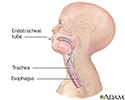Endotracheal intubation
Intubation - endotracheal
Endotracheal intubation is a medical procedure in which a tube is placed into the windpipe (trachea) through the mouth or nose. In most emergency situations it is placed through the mouth.
Whether you are awake (conscious) or not awake (unconscious), you will be given medicine to make it easier to insert the tube.
After endotracheal intubation, you will likely be placed on a breathing machine.
If you are awake after the procedure, your health care provider may give you medicine to reduce your anxiety or discomfort.
Endotracheal intubation is done to:
- Open the airway to give oxygen, medicine, or anesthesia
- Support breathing with certain illnesses, such as pneumonia, emphysema, heart failure, or collapsed lung
- Remove blockages from the airway
- Allow the provider to get a better view of the upper airway
- Protect the lungs in people who are unable to protect their airway and are at risk for breathing in fluid (aspiration). This includes people with certain types of strokes, overdoses, or massive bleeding from the esophagus or stomach.
Risks include:
- Bleeding
- Infection
- Trauma to the voice box (larynx), thyroid gland, vocal cords and windpipe (trachea), or esophagus
- Puncture or tearing (perforation) of body parts in the chest cavity, leading to lung collapse
References
Reardon RF, McGill JW, Clinton JE. Tracheal intubation. In: Roberts JR, ed. Roberts and Hedges' Clinical Procedures in Emergency Medicine . 6th ed. Philadelphia, PA: Elsevier Saunders; 2013:chap 4.
-
Endotracheal intubation - illustration
Introducing a tube into the trachea to provide an open airway is called endotracheal intubation.
Endotracheal intubation
illustration
Review Date: 11/14/2014
Reviewed By: Jacob L. Heller, MD, MHA, Emergency Medicine, Virginia Mason Medical Center, Seattle, WA. Also reviewed by David Zieve, MD, MHA, Isla Ogilvie, PhD, and the A.D.A.M. Editorial team.

